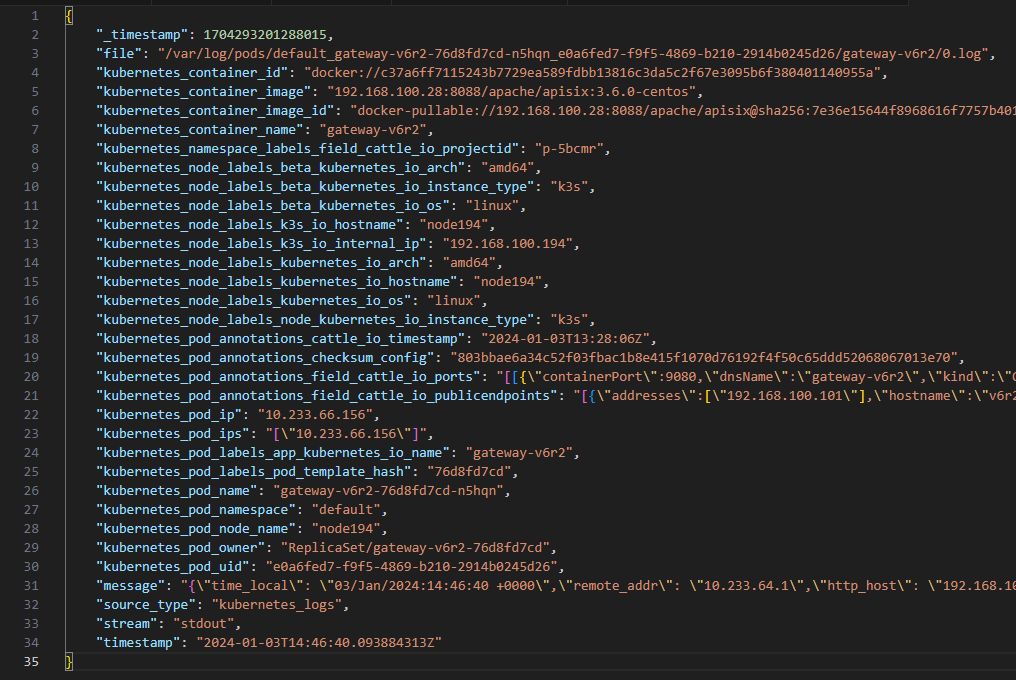Vector使用备忘
Vector是高性能的可观测性数据管道(Observability Pipelines,关于什么是可观测性数据管道可以查看官方文档),用来收集,转换和路由日志和指标数据。
一、为什么使用Vector
高性能,低资源消耗,有一些相关的测评文章:
[Who is the winner — Comparing Vector, Fluent Bit, Fluentd performance by Ajay Gupta IBM Cloud Medium](https://medium.com/ibm-cloud/log-collectors-performance-benchmarking-8c5218a08fea) - 构建高性能可观测性数据流水线:使用Vector实现实时日志分析 - 知乎 (zhihu.com)
官方文档的Tuning(调优)页面这样说:
Vector is written in Rust and therefore doesn’t include a runtime or a virtual machine. There are no special service-level steps you need to undertake to improve performance as Vector takes full advantage of all system resources by default and without any adjustments.
翻译过来就是:
Vector 是用 Rust 编写的,因此不包含运行时或虚拟机。 您无需执行任何特殊的服务级别步骤即可提高性能,因为 Vector 默认情况下会充分利用所有系统资源,且无需任何调整。
| 除了性能之外,Vector还具有一些高级特性,比如:自适应并发请求([Adaptive request concurrency (ARC) | Vector documentation](https://vector.dev/docs/about/under-the-hood/networking/arc/)。请求下游服务时,根据响应速率自适应调节自身的并发速率)。 |
二、部署
参考文档:Install Vector on Docker | Vector documentation
2.1 拉取镜像
这里记录的是实际操作时使用的镜像信息,Vector的镜像每天都会自动构建
nightly镜像并且上传到Docker Hub,这里我们使用已经Release的版本。
1
docker pull timberio/vector:0.39.0-alpine
2.2 部署到k8s
最终部署时使用的完整YAML内容是:
1
2
3
4
5
6
7
8
9
10
11
12
13
14
15
16
17
18
19
20
21
22
23
24
25
26
27
28
29
30
31
32
33
34
35
36
37
38
39
40
41
42
43
44
45
46
47
48
49
50
51
52
53
54
55
56
57
58
59
60
61
62
63
64
65
66
67
68
69
70
71
72
73
74
75
76
77
78
79
80
81
82
83
84
85
86
87
88
89
90
91
92
93
94
95
96
97
98
99
100
101
102
103
104
105
106
107
108
apiVersion: apps/v1
kind: DaemonSet
metadata:
labels:
app: vector
name: vector
namespace: ops
spec:
selector:
matchLabels:
app: vector
template:
metadata:
labels:
app: vector
spec:
containers:
- env:
- name: VECTOR_SELF_NODE_NAME
valueFrom:
fieldRef:
apiVersion: v1
fieldPath: spec.nodeName
image: timberio/vector:0.39.0-alpine
imagePullPolicy: IfNotPresent
name: vector
ports:
- containerPort: 8686
name: 8686tcp02
protocol: TCP
volumeMounts:
- mountPath: /var/log/pods
name: podlogdir
- mountPath: /opt/docker-data/docker/containers
name: dockerlogdir
- mountPath: /opt/data/appdata/vector/data
name: vectordata
- mountPath: /root/.kube/config
name: config
subPath: config
- mountPath: /etc/vector/vector.yaml
name: vector
subPath: vector.yaml
imagePullSecrets:
- name: redistry-key
restartPolicy: Always
volumes:
- hostPath:
path: /var/log/pods
type: ""
name: podlogdir
- hostPath:
path: /opt/docker-data/docker/containers
type: ""
name: dockerlogdir
- hostPath:
path: /opt/data/appdata/vector/data
type: ""
name: vectordata
- configMap:
defaultMode: 292
items:
- key: config
path: config
name: kubernetes
optional: false
name: config
- configMap:
defaultMode: 292
items:
- key: vector.yaml
path: vector.yaml
name: vector
optional: false
name: vector
---
apiVersion: v1
kind: Service
metadata:
name: vector
namespace: ops
spec:
ports:
- name: 8686tcp02
port: 8686
protocol: TCP
targetPort: 8686
selector:
app: vector
sessionAffinity: None
type: ClusterIP
---
apiVersion: v1
kind: Service
metadata:
name: vector-lb
namespace: ops
spec:
externalTrafficPolicy: Cluster
ports:
- name: 8686tcp02
port: 8686
protocol: TCP
targetPort: 8686
selector:
app: vector
sessionAffinity: None
type: LoadBalancer
三、配置
Vector有三个重要概念,分别是Sources(数据从哪来),Transforms(对日志进行何种转换),以及Sinks(将数据写到哪里去)。对于这三种概念,都有非常丰富的配置可供选择。
Vector的配置文件默认放置于/etc/vector/vector.yaml,我们先进行一些初始化配置(配置中还能使用环境变量,并且支持多配置文件):
1
2
3
4
5
6
7
8
# 默认文件存储目录,Vector需要一些磁盘空间来持久化当前运行状态
# 例如用来当作磁盘缓冲区,或者保存checkpoints
data_dir: "/opt/data/appdata/vector/data"
# Vector HTTP API配置(默认不启用)
api:
enabled: true
address: "0.0.0.0:8686"
3.1 Sources
| 首先配置日志的Sources,也就是日志来源,当前我们想采集Kubernetes logs,参考文档:[Kubernetes logs | Vector documentation](https://vector.dev/docs/reference/configuration/sources/kubernetes_logs/)。 |
1
2
3
4
sources:
k8s:
type: kubernetes_logs
kube_config_file: /root/.kube/config
3.2 Transforms
日志的转换是关键步骤,如果直接完整记录k8s中采集到的日志,那么结构就像这样: 
内容多固然是好事,可惜有很多内容是我们不需要的,并且其结构不太符合我们的预期,因此我们希望能够借助某种能力将其进行转换,这时候就要用到Transforms。
Vector支持多种Transform方式,我们选用Remap with VRL的方式,因为这种方式不仅和Filter一样可以用来过滤数据,并且在数据转换上的性能比Lua更好(官方文档上描述的是使用Lua进行数据转换大约会比VRL慢百分之60)。
3.2.1 编写脚本转换apisix网关的日志
apisix作为开源网关工具,它的日志详细格式我们无法自定义,在这里,我们希望将其日志转换成如下格式:
将部分k8s日志本身的内容提取成字段,以
k8s_作为前缀,解析message字段中的内容,以app_log_作为前缀,并进行部分数值转换
编写VRL表达式时,官方有许多资料可供参考(包括函数,异常,简单示例等)。并且官方还提供了VRL playground,可以直接将当前数据粘贴上去,一边编写程序一边调试。这里直接粘贴编写好的脚本:
1
2
3
4
5
6
7
8
9
10
11
12
13
14
15
16
17
18
19
20
21
22
23
24
25
26
27
28
29
30
31
32
33
34
. = flatten(., "_")
if (.kubernetes_container_name == "gateway" && starts_with(string!(.message), "{")) {
msg_data = .message
. = {
"k8s_service_name": .kubernetes_container_name,
"k8s_pod_name": .kubernetes_pod_name,
"k8s_namespace": .kubernetes_pod_namespace
}
data = parse_json!(msg_data)
if (is_null(data.request_time) || is_null(data.upstream_response_time)) {
abort
}
data.request_time = string!(data.request_time)
data.upstream_response_time = string!(data.upstream_response_time)
if (is_empty(data.request_time) || is_empty(data.upstream_response_time)) {
abort
}
request_time = parse_float!(data.request_time) * 1000
upstream_response_time = parse_float!(data.upstream_response_time) * 1000
.app_log_time_local = data.time_local
.app_log_remote_addr = data.remote_addr
.app_log_http_host = data.http_host
.app_log_request = data.request
.app_log_status = parse_int!(data.status)
.app_log_body_bytes_sent = parse_int!(data.body_bytes_sent)
.app_log_request_time = request_time
.app_log_http_referer = data.http_referer
.app_log_http_user_agent = data.http_user_agent
.app_log_upstream_addr = data.upstream_addr
.app_log_upstream_status = parse_int!(data.upstream_status)
.app_log_upstream_response_time = upstream_response_time
} else {
abort
}
3.2.2 配置Transforms
这里需要指定transform的inputs,并且将type指定为remap,另外我们还希望abort操作丢弃数据,因此最后的配置为:
1
2
3
4
5
6
7
8
9
10
11
12
13
14
15
16
17
18
19
20
21
22
23
24
25
26
27
28
29
30
31
32
33
34
35
36
37
38
39
40
41
transforms:
apisix_transform:
type: remap
inputs:
- k8s
drop_on_abort: true
source: |-
. = flatten(., "_")
if (.kubernetes_container_name == "gateway" && starts_with(string!(.message), "{")) {
msg_data = .message
. = {
"k8s_service_name": .kubernetes_container_name,
"k8s_pod_name": .kubernetes_pod_name,
"k8s_namespace": .kubernetes_pod_namespace
}
data = parse_json!(msg_data)
if (is_null(data.request_time) || is_null(data.upstream_response_time)) {
abort
}
data.request_time = string!(data.request_time)
data.upstream_response_time = string!(data.upstream_response_time)
if (is_empty(data.request_time) || is_empty(data.upstream_response_time)) {
abort
}
request_time = parse_float!(data.request_time) * 1000
upstream_response_time = parse_float!(data.upstream_response_time) * 1000
.app_log_time_local = data.time_local
.app_log_remote_addr = data.remote_addr
.app_log_http_host = data.http_host
.app_log_request = data.request
.app_log_status = parse_int!(data.status)
.app_log_body_bytes_sent = parse_int!(data.body_bytes_sent)
.app_log_request_time = request_time
.app_log_http_referer = data.http_referer
.app_log_http_user_agent = data.http_user_agent
.app_log_upstream_addr = data.upstream_addr
.app_log_upstream_status = parse_int!(data.upstream_status)
.app_log_upstream_response_time = upstream_response_time
} else {
abort
}
3.3 Sinks
当前需要将日志记录到OpenObserve,其提供了HTTP方式的API,HTTP Sink的文档参考:HTTP | Vector documentation。这里参考了OpenObserve提供的配置示例:Vector - OpenObserve Documentation
1
2
3
4
5
6
7
8
9
10
11
12
13
14
15
16
17
18
19
20
21
22
23
24
25
26
27
28
29
sinks:
openobserve:
type: http
inputs:
- k8s # 使用上面配置的k8s日志source作为输入
uri: http://openobserve:5080/api/k8s/pods/_json
method: post
auth:
strategy: basic
user: root@example.com
password: Complexpass#123
compression: gzip
encoding:
codec: json
timestamp_format: "rfc3339"
apisix_openobserve:
type: http
inputs:
- apisix_transform # 使用上面配置的transform作为输入
uri: http://openobserve:5080/api/services/gateway/_json
method: post
auth:
strategy: basic
user: root@example.com
password: Complexpass#123
compression: gzip
encoding:
codec: json
timestamp_format: "rfc3339"